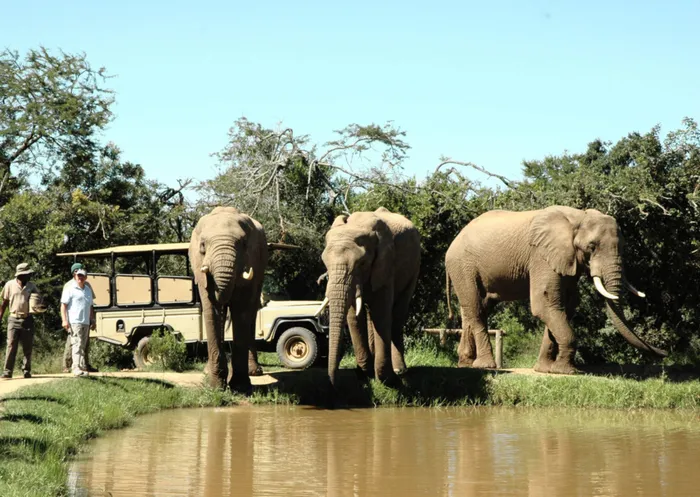Doleful elephants and speedy tortoises

Does the joy of having a picture taken sitting on an elephant's leg count more than the animal's 'suffering' of going down on all fours? Does the joy of having a picture taken sitting on an elephant's leg count more than the animal's 'suffering' of going down on all fours?
At the entrance to Addo Elephant National Park a sign proclaims: “Dung beetles have right of way. Do not run over dung beetles or dung.”
My guide book advised that Addo is the home of the flightless dung beetle. And the park’s own entrance sign seemed to imply the beetles were so thick on the ground visitors had to be careful not to squash them. Driving through the park, I kept a sharp lookout for small balls rolling down the road. There was certainly plenty of dung. But no balls and no beetles.
Eventually I asked the driver of our game viewing vehicle where the dung beetles were. “Oh, they are all around,” he said. “There are lots of them everywhere. But you only see them when it rains.”
Sadly, it was dry, very dry, so it was hardly surprising that we did not see any dung beetles. I would have to make do with elephants instead. And warthogs. The park has a lot of very complacent warthogs. In other places we had been, the warthogs were skittish and hard to photograph. But here there were not only huge numbers but they seemed happy to lounge around and have their pictures taken.
At the first waterhole we came to, half a dozen warthogs were drinking along with a couple of ostriches. Our driver looked at them with a jaundiced eye.
“There are too many warthogs in this park,” he said. “They are everywhere. We have had to bring in extra lions and hyenas to get the numbers down. But they haven’t done the job yet.”
Next we slowed to allow a large tortoise to stroll across the road. Tortoises have right of way too.
Our driver turned off the main road through the park on to a dusty track and suddenly we were right in the middle of a herd of elephants – a huge dominant bull, several big old mothers, lots of smaller young adults and cute youngsters. As we watched them eating, playing and interacting, our driver explained what a huge success story Addo is.
“When the park was established in 1931 there were only 11 elephants left. Now there are more than 450. There are six herds like this whose numbers range from as small as 20 to more than 80.”
At the end of the track we came to a large waterhole where about 20 elephants, mostly youngsters, were playing in the water with several dignified elders supervising.
Our driver explained that bath time for elephants is completely different to bath time for humans.
“They don’t want to get clean, they want to get dirty. Elephant skin is very thick and tough, but also very sensitive, so in hot sunny weather they need to smear it with a good layer of muddy sunblock.”
On the way back we passed many more elephants and ample supplies of dung but still no dung beetles. Just before the gate we pulled up to watch another tortoise sprinting down the side of the road.
“Going somewhere in a big hurry,” said our guide. “Must have a girlfriend waiting for him.”
Maybe. But I hope he wasn’t in such a hurry that he forgot to be careful where he put his feet. After all, dung and dung beetles take priority in these parts.
l The Elephant House is a marvellous B&B close to the gates of Addo Elephant National Park. Built in the style of an old farmhouse, it offers comfortable accommodation, great meals, excellent tours and, several times a week, displays of traditional dancing by a group of students. See www.elephanthouse.co.za
Pay a visit to www.sanparks.org/parks/addo/ – New Zealand Herald